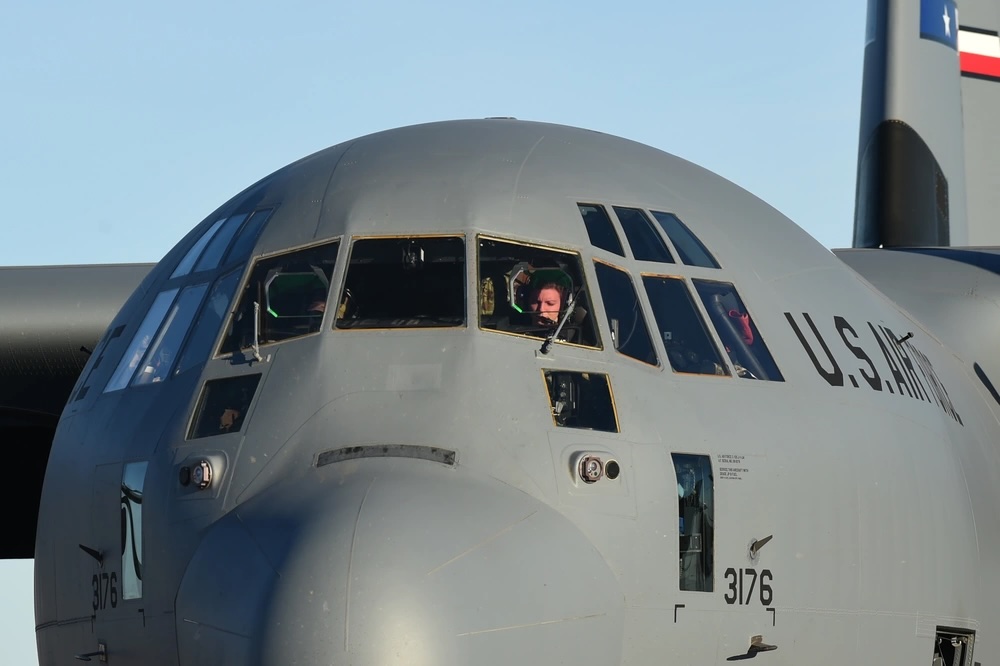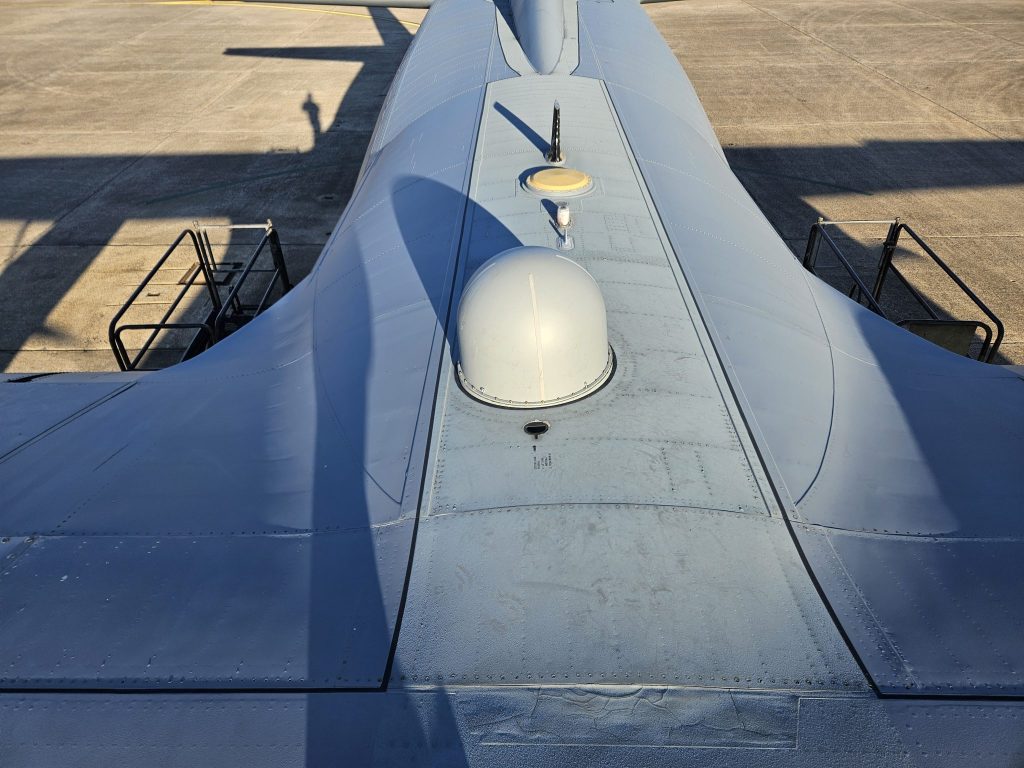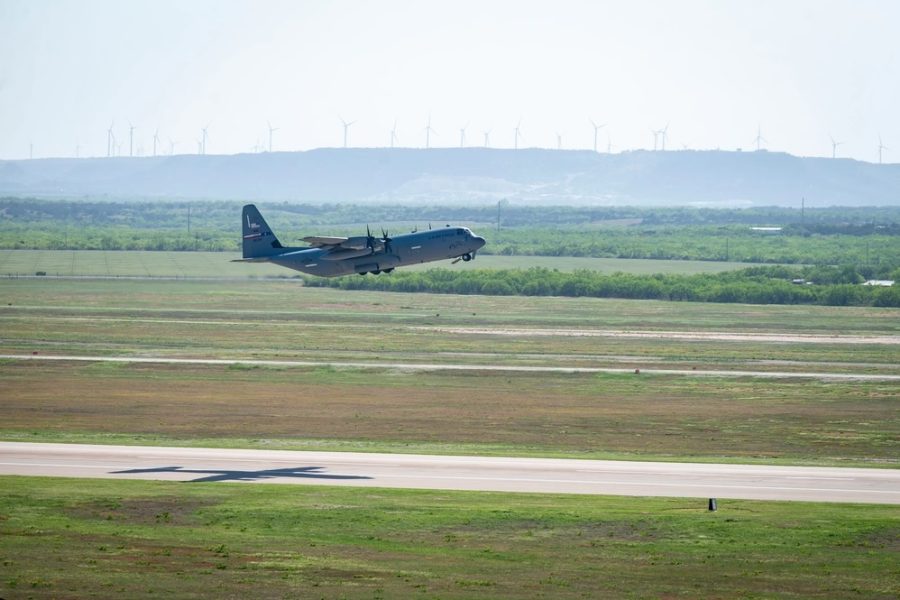An Air Force C-130J Super Hercules crew braved a long flight around half the planet earlier this month as part of an experiment testing how quickly they could respond to a crisis in the Indo-Pacific.
Dubbed Hazard Leap, the test kicked off on April 18 when two full crews—three pilots and two loadmasters each—in a C-130J assigned to the 40th Airlift Squadron took off from Dyess Air Force Base, Texas, bound for Guam, a U.S. territory in the western Pacific that serves as a key military hub. The flight took 26 hours and 33 minutes, including a stop for gas in Hawaii along the way. The C-130J had a toilet on board, but the crew also took a quick bathroom break in Hawaii during the refueling stop, a Dyess Air Force Base spokesperson said.
The “remarkable” journey demonstrated the C-130J’s “ability to operate for extended periods without stopping,” Dyess wrote in a press release. The four-engine turboprop plane could fly even longer than usual thanks to external fuel tanks slung beneath its wings. The tanks added about 17,000 pounds of gas—roughly four extra hours of flying—according to Capt. Anna Santori, a pilot who flew the Hazard Leap mission.
The 40th Airlift Squadron is not the first to fly a C-130J with tanks, but, according to the release, it is the first in Air Mobility Command to use them in a maximum endurance operation (MEO), the term for very long flights meant to test the capabilities of the crew and the aircraft. Units across the Air Force have flown MEOs in recent years to prepare for a possible conflict with China over the vast Pacific Ocean, where Air Mobility Command will be hard-pressed to provide airlift, aerial refueling, and aeromedical evacuation to the rest of the military.
“There is too much water and too much distance [in the Pacific] for anyone else to do it relevantly, at pace, at speed, at scale,” AMC boss Gen. Mike Minihan said in 2022. “Everybody’s role is critical, but Air Mobility Command is the maneuver for the Joint Force. If we don’t have our act together, nobody wins.”

Past MEOs included a 36-hour KC-46 flight over the Pacific and a 72-hour KC-135 mission back and forth over the continental U.S. Part of the challenge is the physical and mental strain of flying an aircraft for a long period of time. Air Mobility Command is working on new solutions to help crews develop better awareness and diagnostics of their fatigue and alertness levels, much the same way the plane’s performance is measured by cockpit instruments.
“The status quo is we just ask the crew, ‘Hey, how’s everyone feeling?’” Maj. Nate Mocalis, who took part in the 72-hour KC-135 flight, said in January. “But as humans, we’re really poor judges of objectively assessing our actual fatigue and risk due to our levels of alertness.”
Another part of the challenge is connectivity: mobility aircraft have to be able to send information over vast distances in order to arrive at the right place and time as part of a complex battle plan, but today much of the mobility fleet relies on old-fashioned voice-to-voice communication, which takes a while and is vulnerable to misunderstandings. Minihan is pushing to adopt available technology that allows for secure beyond line of sight data exchange.
“I can just look at a tablet or a screen and I can see it,” Minihan told Air & Space Forces Magazine in February. “I can know which airfields have been bombed or damaged. Then I don’t have to just show up, look at the runway, and say that one’s not for me today. These things are all essential.”
Airmen at Little Rock Air Force Base made progress on the connectivity challenge during a separate MEO earlier this year. Maintainers with the 19th Airlift Wing installed a satellite communications terminal, called the SD/R4i Tactical Removable Airborne Satellite Communications solution, onto the hatch of a C-130J, then the crew successfully tested it during a 26-hour, 20-minute flight, according to the manufacturer, SD Government.

“Performed as part of Exercise Gnarly Explodeo, the maximum endurance mission recorded 100 percent reliability and availability from the TRASC system as it facilitated secure command and control data communications, defense applications, intelligence updates, electronic flight bags, video conferencing, voice over internet and WiFi calls,” the manufacturer, SD Government, wrote in a press release. Col. Denny Davies, commander of the 19th Airlift Wing, seemed to agree.
“This platform enables global command and control, providing our crew with unparalleled situational awareness,” Davies said in the release. “It makes the C-130 much more resilient and capable in the vastness of the Pacific, reinforcing the Air Force’s core tenant of distributed control.”
It was not clear if the 317th Airlift Wing also tried out new connectivity methods during Hazard Leap, but they have more challenges coming up, such as working with U.S. Marines in the Philippines during Balikatan, an annual exercise that started on April 22 this year. The mission sets there will likely include landing at blacked-out airfields, loading and off-loading High Mobility Artillery Rocket Systems (HIMARS), and forward area refueling, the Dyess spokesperson said. Hopefully those challenges will not look so difficult compared to 26 hours spent aboard a C-130 for Hazard Leap.
“The successful completion of Hazard Leap is a testament to our team’s dedication and the remarkable capabilities of the C-130J Super Hercules,” Maj. Alex Leach, mission commander and 40th Airlift Squadron assistant director of operations, said in the release. “This operation set a new standard for our squadron and this airframe; it serves as a stepping-stone for future missions.”
